Morphological Characteristics and Comparative Chloroplast Genome Analyses between Red and White Flower Phenotypes of Pyracantha fortuneana (Maxim.) Li (Rosaceae), with Implications for Taxonomy and Phylogeny
Abstract
:1. Introduction
2. Materials and Methods
2.1. Sample Collection and Genome Sequencing
2.2. Chloroplast Genome Assembly and Annotation
2.3. Comparative Chloroplast Genome Analyses
2.4. Codon Usage and RNA Editing Analyses
2.5. Selection Pressure and Analysis
2.6. Identification of SSRs and Highly Variable Regions
2.7. Genetic Distance Analyses
2.8. Phylogenetic Analyses
3. Results
3.1. Chloroplast Genome Characteristics
3.2. Whole-Chloroplast-Genome Comparison
3.3. Codon Usage Bias and RNA Editing Sites
3.4. Selection Pressure
3.5. SSRs and Highly Divergent Regions
3.6. Genetic Distance
3.7. Phylogenetic Relationships
4. Discussion
4.1. Chloroplast Genome Features
4.2. Morphology, Phylogeny, and Taxonomy of the Red Flower Phenotype of P. fortuneana
4.3. Limitations and Future Directions
Supplementary Materials
Author Contributions
Funding
Institutional Review Board Statement
Informed Consent Statement
Data Availability Statement
Acknowledgments
Conflicts of Interest
References
- Yu, D.J.; Jiang, W.F. Rosaceae. In Flora Reipublicae Popularis Sinicae, 2nd ed.; Yu, D.J., Ed.; Science Press: Beijing, China, 1974; Volume 3, pp. 179–186. [Google Scholar]
- Govaerts, R.; Lughadha, E.N.; Black, N.; Turner, R.; Paton, A. The world checklist of vascular plants, a continuously updated resource for exploring global plant diversity. Sci. Data 2021, 8, 215. [Google Scholar] [CrossRef] [PubMed]
- Gu, C.Z.; Stephen, A.S. Rosaceae. In Flora of China, 2nd ed.; Wu, Z.Y., Raven, P.H., Eds.; Science Press: Beijing, China; Missouri Botanical Garden Press: St. Louis, MI, USA, 2003; Volume 9, pp. 108–111. [Google Scholar]
- Morgan, D.R.; Soltis, D.E.; Robertson, K.R. Systematic and evolutionary implications of rbcL sequence variation in Rosaceae. Am. J. Bot. 1994, 81, 890–903. [Google Scholar] [CrossRef]
- Potter, D.; Eriksson, T.; Evans, R.C.; Oh, S.; Smedmark, J.E.E.; Morgan, D.R.; Kerr, M.; Robertson, K.R.; Arsenault, M.; Dickinson, T.A.; et al. Phylogeny and classification of Rosaceae. Plant Syst. Evol. 2007, 266, 5–43. [Google Scholar] [CrossRef]
- Liu, B.; Ye, J.F.; Liu, S.; Wang, Y.; Yang, Y.; Lai, Y.J.; Zeng, G.; Lin, Q. Families and genera of Chinese angiosperms: A synoptic classification based on APG III. Biodivers. Sci. 2015, 23, 225–231. [Google Scholar] [CrossRef]
- Chen, Z.D.; Lu, A.M.; Liu, B.; Ye, J.F. Tree of Life for Chinese Vascular Plants; Science Press: Beijing, China, 2020. [Google Scholar]
- Li, D.Z. The Families and Genera of Chinese Vascular Plants; Science Press: Beijing, China, 2020. [Google Scholar]
- Liu, B.B.; Hong, D.Y.; Zhou, S.L.; Xu, C.; Dong, W.P.; Johnson, G.; Wen, J. Phylogenomic analyses of the Photinia complex support the recognition of a new genus Phippsiomeles and the resurrection of a redefined Stranvaesia in Maleae (Rosaceae). J. Syst. Evol. 2019, 57, 678–694. [Google Scholar] [CrossRef] [Green Version]
- Liu, B.B.; Liu, G.N.; Hong, D.Y.; Wen, J. Eriobotrya belongs to Rhaphiolepis (Maleae, Rosaceae): Evidence from chloroplast genome and nuclear ribosomal DNA data. Front. Plant Sci. 2019, 10, 1731. [Google Scholar] [CrossRef] [Green Version]
- Liu, B.B.; Campbell, C.S.; Hong, D.Y.; Wen, J. Phylogenetic relationships and chloroplast capture in the Amelanchier-Malacomeles-Peraphyllum clade (Maleae, Rosaceae): Evidence from chloroplast genome and nuclear ribosomal DNA data using genome skimming. Mol. Phylogenet. Evol. 2020, 147, 106784. [Google Scholar] [CrossRef]
- Liu, B.B.; Ren, C.; Kwak, M.; Hodel, R.G.; Xu, C.; He, J.; Zhou, W.B.; Huang, C.H.; Ma, H.; Qian, G.Z.; et al. Phylogenomic conflict analyses in the apple genus Malus s.l. reveal widespread hybridization and allopolyploidy driving diversification, with insights into the complex biogeographic history in the Northern Hemisphere. J. Integr. Plant Biol. 2022, 64, 1020–1043. [Google Scholar] [CrossRef]
- Lingyu, W.; Li, R.; Zhang, Q.; Jia, L.; Ting, T.; Ting, Z.; Wu, C.J.; Qiang, R.; Xufeng, P.; Peng, W. Pyracantha fortuneana (Maxim.) Li: A comprehensive review of its phytochemistry, pharmacological properties, and product development. Front. Sustain. Food Syst. 2022, 6, 940900. [Google Scholar]
- Zhao, C.F.; Li, S.; Song, G.H.; Yu, L.J.; Zhang, H. Extraction optimization approach to improve accessibility of functional fraction based on combination of total polyphenol, chromatographic profiling and antioxidant activity evaluation: Pyracantha fortuneana fruit as an example. J. Func. Foods 2013, 5, 715–728. [Google Scholar] [CrossRef]
- Han, W.Q.; Zhang, G.F. Study on nutritional components and antioxidant activity of total flavonoids in Pyracantha fruit. Agric. Sci. 2019, 9, 399–404. [Google Scholar]
- Chen, K.; Tan, Q.Q. Analysis of nutrient components of Pyracantha fruit. Chin. Food Saf. Mag. 2021, 15, 94–96. [Google Scholar]
- Wang, L.R. Red flower phenotype of Chinese firethorn was found in western Hubei. Life World 1987, 4, 2. (In Chinese) [Google Scholar]
- Neuhaus, H.E.; Emes, M.J. Nonphotosynthetic metabolism in plastids. Annu. Rev. Plant Physiol. Plant Mol. Biol. 2000, 51, 111–140. [Google Scholar] [CrossRef] [PubMed]
- Green, B.R. Chloroplast genomes of photosynthetic eukaryotes. Plant J. 2011, 66, 34–44. [Google Scholar] [CrossRef] [PubMed]
- Daniell, H.; Lin, C.S.; Yu, M.; Chang, W.J. Chloroplast genomes: Diversity, evolution, and applications in genetic engineering. Genome Biol. 2016, 17, 134. [Google Scholar] [CrossRef] [PubMed] [Green Version]
- Bendich, A.J. Circular chloroplast chromosomes: The grand illusion. Plant Cell 2004, 16, 1661–1666. [Google Scholar] [CrossRef] [PubMed] [Green Version]
- Li, X.; Yang, Y.; Henry, R.J.; Rossetto, M.; Wang, Y.; Chen, S. Plant DNA barcoding: From gene to genome. Biol. Rev. 2015, 90, 157–166. [Google Scholar] [CrossRef]
- Tonti-Filippini, J.; Nevill, P.G.; Dixon, K.; Small, I. What can we do with 1000 plastid genomes? Plant J. 2017, 90, 808–818. [Google Scholar] [CrossRef] [PubMed] [Green Version]
- Gitzendanner, M.A.; Soltis, P.S.; Yi, T.S.; Li, D.Z.; Soltis, D.E. Plastome phylogenetics: 30 years of inferences into plant evolution. Adv. Bot. Res. 2018, 85, 293–313. [Google Scholar]
- Wicke, S.; Naumann, J. Molecular evolution of plastid genomes in parasitic flowering plants. Adv. Bot. Res. 2018, 85, 315–347. [Google Scholar]
- Fu, C.N.; Wu, C.S.; Ye, L.J.; Mo, Z.Q.; Liu, J.; Chang, Y.W.; Li, D.Z.; Chaw, S.M.; Gao, L.M. Prevalence of isomeric plastomes and effectiveness of plastome super-barcodes in yews (Taxus) worldwide. Sci. Rep. 2019, 9, 2773. [Google Scholar] [CrossRef] [PubMed] [Green Version]
- Li, J.L.; Wang, S.; Yu, J.; Wang, L.; Zhou, S.L. A modified CTAB protocol for plant DNA extraction. Chin. Bull. Bot. 2013, 48, 72–78. [Google Scholar]
- Jin, J.J.; Yu, W.B.; Yang, J.B.; Song, Y.; DePamphilis, C.W.; Yi, T.S.; Li, D.Z. GetOrganelle: A fast and versatile toolkit for accurate de novo assembly of organelle genomes. Genome Biol. 2020, 21, 241. [Google Scholar] [CrossRef]
- Wick, R.R.; Schultz, M.B.; Zobel, J.; Holt, K.E. Bandage: Interactive visualization of de novo genome assemblies. Bioinformatics 2015, 31, 3350–3352. [Google Scholar] [CrossRef] [PubMed] [Green Version]
- Qu, X.J.; Moore, M.J.; Li, D.Z.; Yi, T.S. PGA: A software package for rapid, accurate, and flexible batch annotation of plastomes. Plant Methods 2019, 15, 50. [Google Scholar] [CrossRef] [PubMed] [Green Version]
- Tillich, M.; Lehwark, P.; Pellizzer, T.; Ulbricht-Jones, E.S.; Fischer, A.; Bock, R.; Greiner, S. GeSeq—Versatile and accurate annotation of organelle genomes. Nucleic Acids Res. 2017, 45, W6–W11. [Google Scholar] [CrossRef]
- Zheng, S.; Poczai, P.; Hyvonen, J.; Tang, J.; Amiryousefi, A. Chloroplot an online program for the versatile plotting of organelle genomes. Front. Genet. 2020, 11, 576124. [Google Scholar] [CrossRef]
- Kearse, M.; Moir, R.; Wilson, A.; Stones-Havas, S.; Cheung, M.; Sturrock, S.; Buxton, S.; Cooper, A.; Markowitz, S.; Duran, C.; et al. Geneious basic: An integrated and extendable desktop software platform for the organization and analysis of sequence data. Bioinformatics 2012, 28, 1647–1649. [Google Scholar] [CrossRef] [Green Version]
- Darling, A.C.; Mau, B.; Blattner, F.R.; Perna, N.T. Mauve: Multiple alignment of conserved genomic sequence with rearrangements. Genome Res. 2004, 14, 1394–1403. [Google Scholar] [CrossRef] [Green Version]
- Darzentas, N. Circoletto: Visualizing sequence similarity with Circos. Bioinformatics 2010, 26, 2620–2621. [Google Scholar] [CrossRef] [PubMed] [Green Version]
- Kumar, S.; Stecher, G.; Tamura, K. MEGA7: Molecular evolutionary genetics analysis version 7.0 for bigger datasets. Mol. Biol. Evol. 2016, 33, 1870–1874. [Google Scholar] [CrossRef] [PubMed] [Green Version]
- Mower, J.P. The PREP suite: Predictive RNA editors for plant mitochondrial genes, chloroplast genes and user-defined alignments. Nucleic Acids Res. 2009, 37, W253–W259. [Google Scholar] [CrossRef] [PubMed]
- Weaver, S.; Shank, S.D.; Spielman, S.J.; Li, M.; Muse, S.V.; Kosakovsky Pond, S.L. Datamonkey 2.0: A modern web application for characterizing selective and other evolutionary processes. Mol. Biol. Evol. 2018, 35, 773–777. [Google Scholar] [CrossRef] [Green Version]
- Edgar, R.C. MUSCLE: Multiple sequence alignment with high accuracy and high throughput. Nucleic Acids Res. 2004, 32, 1792–1797. [Google Scholar] [CrossRef] [Green Version]
- Talavera, G.; Castresana, J. Improvement of phylogenies after removing divergent and ambiguously aligned blocks from protein sequence alignments. Syst. Biol. 2007, 56, 564–577. [Google Scholar] [CrossRef] [Green Version]
- Zhang, D.; Gao, F.; Jakovlić, I.; Zou, H.; Zhang, J.; Li, W.X.; Wang, G.T. PhyloSuite: An integrated and scalable desktop platform for streamlined molecular sequence data management and evolutionary phylogenetics studies. Mol. Ecol. Resour. 2020, 20, 348–355. [Google Scholar] [CrossRef]
- Beier, S.; Thiel, T.; Munch, T.; Scholz, U.; Mascher, M. MISA-web: A web server for microsatellite prediction. Bioinformatics 2017, 33, 2583–2585. [Google Scholar] [CrossRef] [Green Version]
- Librado, P.; Rozas, J. DnaSP v5: A software for comprehensive analysis of DNA polymorphism data. Bioinformatics 2009, 25, 1451–1452. [Google Scholar] [CrossRef] [Green Version]
- Saitou, N.; Nei, M. The neighbor-joining method: A new method for reconstructing phylogenetic trees. Mol. Biol. Evol. 1987, 4, 406–425. [Google Scholar]
- Katoh, K.; Standley, D.M. MAFFT multiple sequence alignment software version 7: Improvements in performance and usability. Mol. Biol. Evol. 2013, 30, 772–780. [Google Scholar] [CrossRef] [PubMed] [Green Version]
- Kalyaanamoorthy, S.; Minh, B.Q.; Wong, T.K.F.; von Haeseler, A.; Jermiin, L.S. ModelFinder: Fast model selection for accurate phylogenetic estimates. Nat. Methods 2017, 14, 587–589. [Google Scholar] [CrossRef] [PubMed] [Green Version]
- Nguyen, L.T.; Schmidt, H.A.; von Haeseler, A.; Minh, B.Q. IQ-TREE: A fast and effective stochastic algorithm for estimating maximum-likelihood phylogenies. Mol. Biol. Evol. 2015, 32, 268–274. [Google Scholar] [CrossRef] [PubMed]
- Ronquist, F.; Teslenko, M.; Van Der Mark, P.; Ayres, D.L.; Darling, A.; Höhna, S.; Larget, B.; Liu, L.; Suchard, M.A.; Huelsenbeck, J.P. MrBayes 3.2: Efficient Bayesian phylogenetic inference and model choice across a large model space. Syst. Biol. 2012, 61, 539–542. [Google Scholar] [CrossRef] [PubMed] [Green Version]
- Stover, B.C.; Muller, K.F. TreeGraph 2: Combining and visualizing evidence from different phylogenetic analyses. BMC Bioinform. 2010, 11, 7. [Google Scholar] [CrossRef] [PubMed] [Green Version]
- Muraguri, S.; Xu, W.; Chapman, M.; Muchugi, A.; Oluwaniyi, A.; Oyebanji, O.; Liu, A. Intraspecific variation within Castor bean (Ricinus communis L.) based on chloroplast genomes. Ind. Crop. Prod. 2020, 155, 112779. [Google Scholar] [CrossRef]
- Lu, R.; Chen, M.; Feng, Y.; Yuan, N.; Zhang, Y.; Cao, M.; Liu, J.; Wang, Y.; Hang, Y.; Sun, X. Comparative plastome analyses and genomic resource development in wild rice (Zizania spp., Poaceae) using genome skimming data. Ind. Crop. Prod. 2022, 186, 115244. [Google Scholar] [CrossRef]
- Strauss, S.H.; Palmer, J.D.; Howe, G.T.; Doerksen, A.H. Chloroplast genomes of two conifers lack a large inverted repeat and are extensively rearranged. Proc. Natl. Acad. Sci. USA 1988, 85, 3898–3902. [Google Scholar] [CrossRef]
- Necsulea, A.; Lobry, J.R. A new method for assessing the effect of replication on DNA base composition asymmetry. Mol. Biol. Evol. 2007, 24, 2169–2179. [Google Scholar] [CrossRef] [Green Version]
- Wu, C.S.; Chaw, S.M. Highly rearranged and size-variable chloroplast genomes in conifers II clade (cupressophytes): Evolution towards shorter intergenic spacers. Plant Biotechnol. J. 2014, 12, 344–353. [Google Scholar] [CrossRef]
- Nowicki, M.; Huff, M.L.; Staton, M.E.; Trigiano, R.N. Chloroplast genome of the invasive Pyrus calleryana underscores the high molecular diversity of the species. J. Appl. Genet. 2022, 63, 463–467. [Google Scholar] [CrossRef] [PubMed]
- Yang, J.; Kim, S.H.; Pak, J.H.; Kim, S.C. Infrageneric plastid genomes of Cotoneaster (Rosaceae): Implications for the plastome evolution and origin of C. wilsonii on Ulleung Island. Genes 2022, 13, 728. [Google Scholar] [CrossRef] [PubMed]
- Millen, R.S.; Olmstead, R.G.; Adams, K.L.; Palmer, J.D.; Lao, N.T.; Heggie, L.; Kavanagh, T.A.; Hibberd, J.M.; Gray, J.C.; Morden, C.W.; et al. Many parallel losses of infA from chloroplast DNA during angiosperm evolution with multiple independent transfers to the nucleus. Plant Cell 2001, 13, 645–658. [Google Scholar] [CrossRef] [PubMed] [Green Version]
- Zhu, L.; Xian, F.; Zhang, Q.; Hu, J. Research progress of RNA editing. Biotechnol. Bull. 2022, 38, 1–14. [Google Scholar]
- He, P.; Huang, S.; Xiao, G.; Zhang, Y.; Yu, J. Abundant RNA editing sites of chloroplast protein-coding genes in Ginkgo biloba and an evolutionary pattern analysis. BMC Plant Biol. 2016, 16, 1–12. [Google Scholar] [CrossRef] [Green Version]
- Yang, Z.; Nielsen, R. Estimating synonymous and nonsynonymous substitution rates under realistic evolutionary models. Mol. Biol. Evol. 2000, 17, 32–43. [Google Scholar] [CrossRef] [Green Version]
- Khakhlova, O.; Bock, R. Elimination of deleterious mutations in plastid genomes by gene conversion. Plant J. 2006, 46, 85–94. [Google Scholar] [CrossRef]
- Cai, S.Y. Effects of GA3, Ca2+ on Anthocyanin and Phenylalanine Amonia Lyase in Stem of Anthurium andraeanum. Acta Hortic. Sin. 2004, 31, 343–346. [Google Scholar]
- Ma, X.Y. Effects of Different Application Rates of Nitrogen, Phosphorus and Potassium on Leaf and Fruit Quality of Blue Honeysuckle (Lonicera caerulea L.). Master’s Thesis, Northeast Agricultural University, Harbin, China, 2021. [Google Scholar]
- Cui, D.; Zhao, S.; Xu, H.; Allan, A.C.; Zhang, X.; Fan, L.; Chen, L.; Su, J.; Shu, Q.; Li, K. The interaction of MYB, bHLH and WD40 transcription factors in red pear (Pyrus pyrifolia) peel. Plant Mol. Biol. 2021, 106, 407–417. [Google Scholar] [CrossRef]
- Wen, J.X.; Wang, C.L.; Feng, H.; Li, S.S.; Wang, L.S.; Hua, W.R.; Wei, Z.S. Research progress on flower color of rose. Acta Horticulturae Sinica 2021, 48, 2044–2056. [Google Scholar]
- Sapir, Y.; Gallagher, M.K.; Senden, E. What maintains flower colour variation within populations? Trends Ecol. Evol. 2021, 36, 507–519. [Google Scholar] [CrossRef] [PubMed]
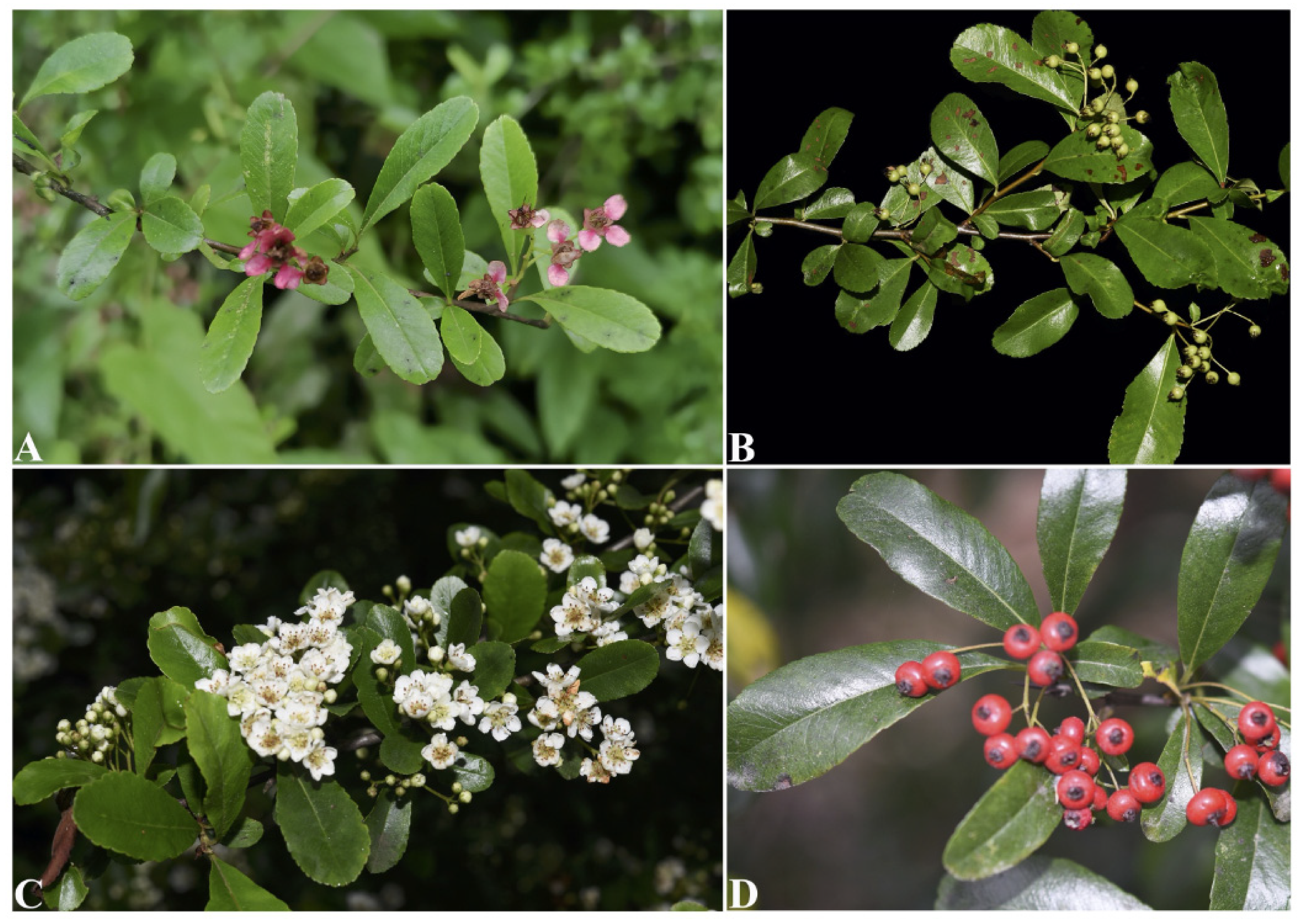
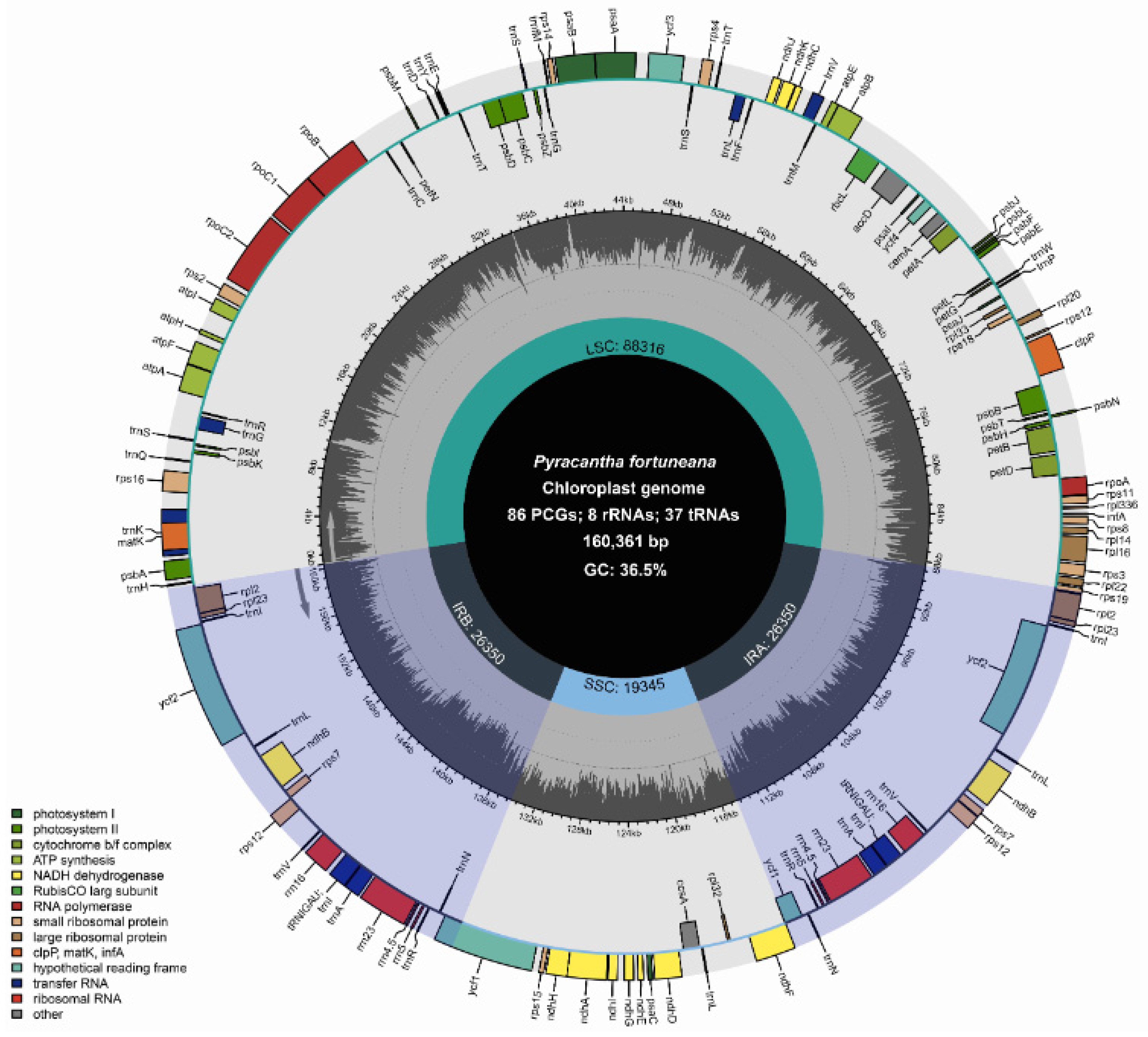
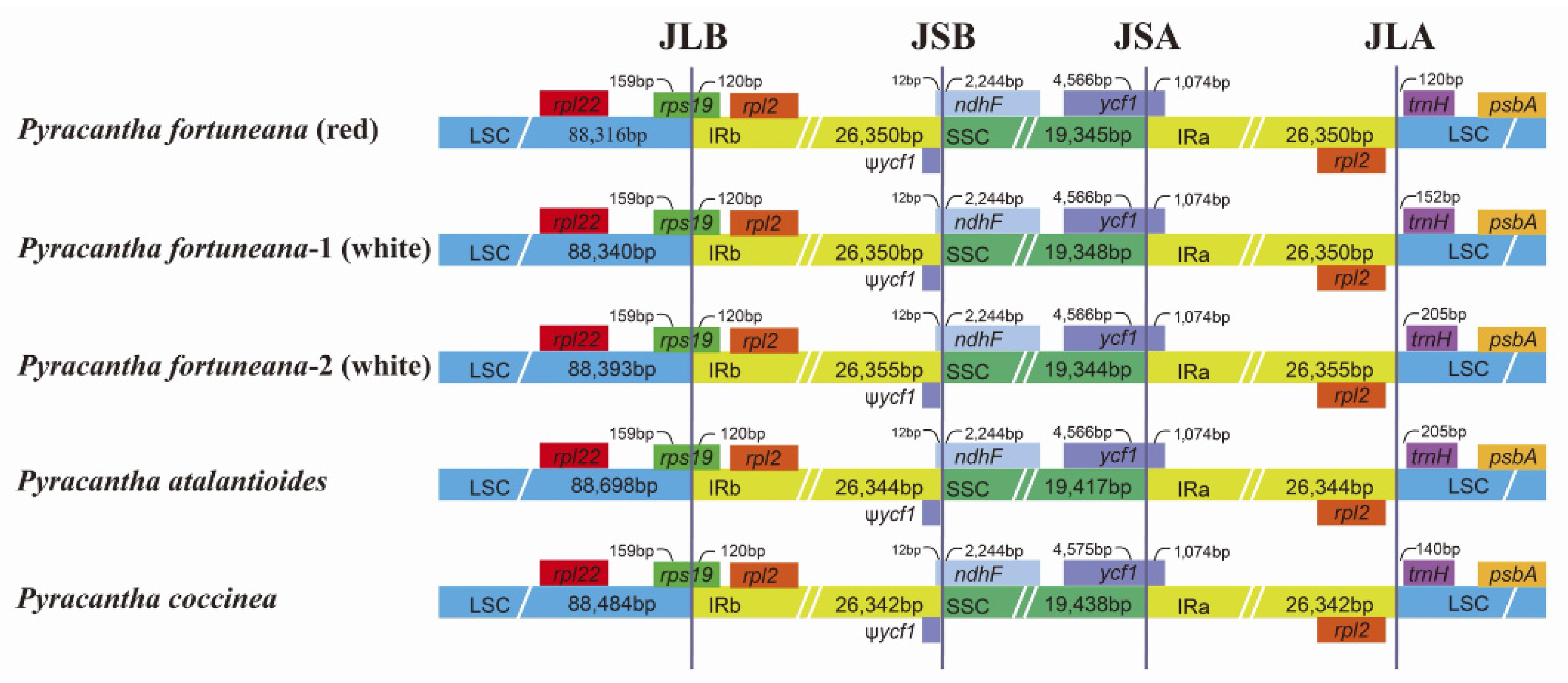
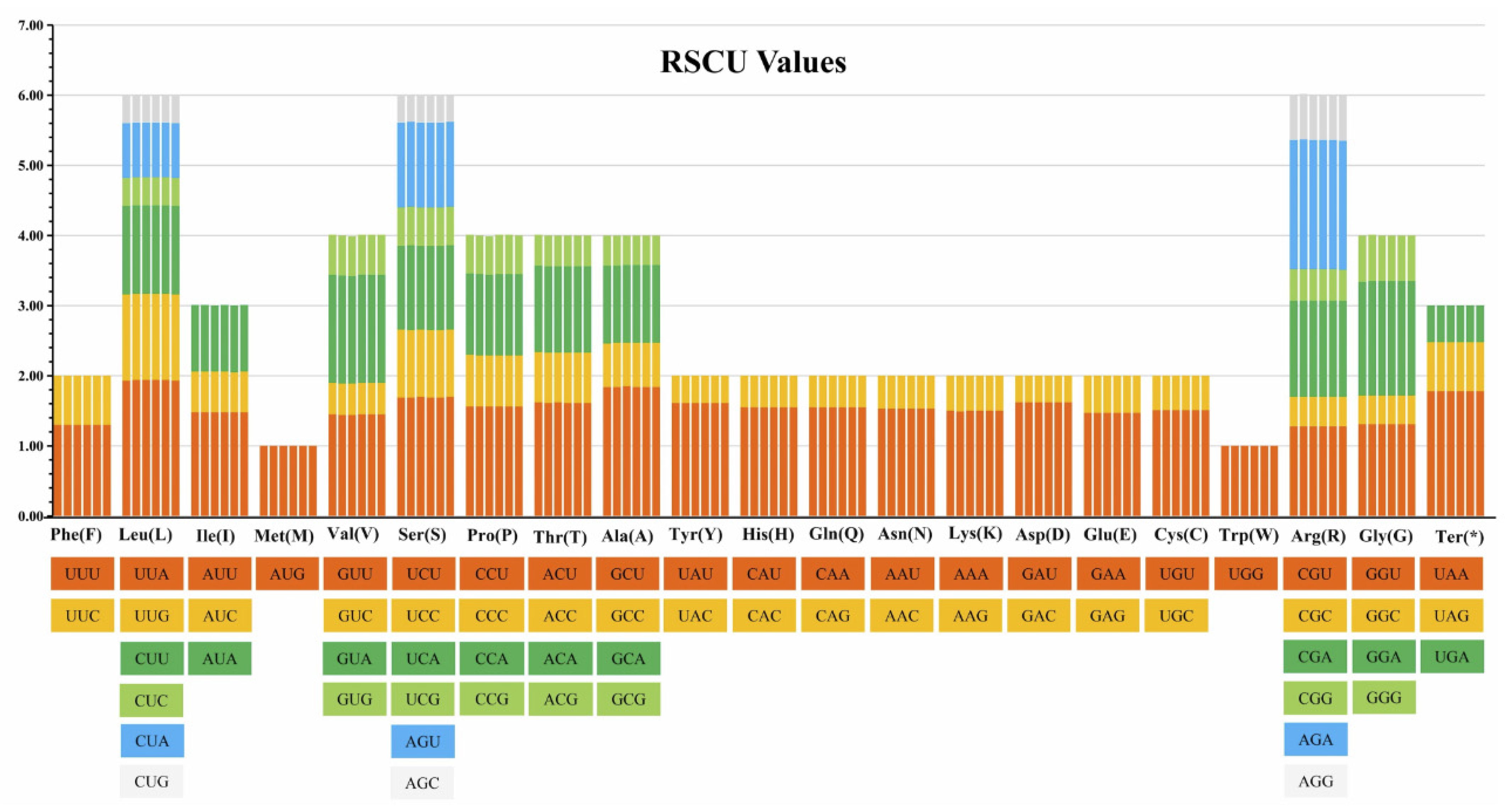
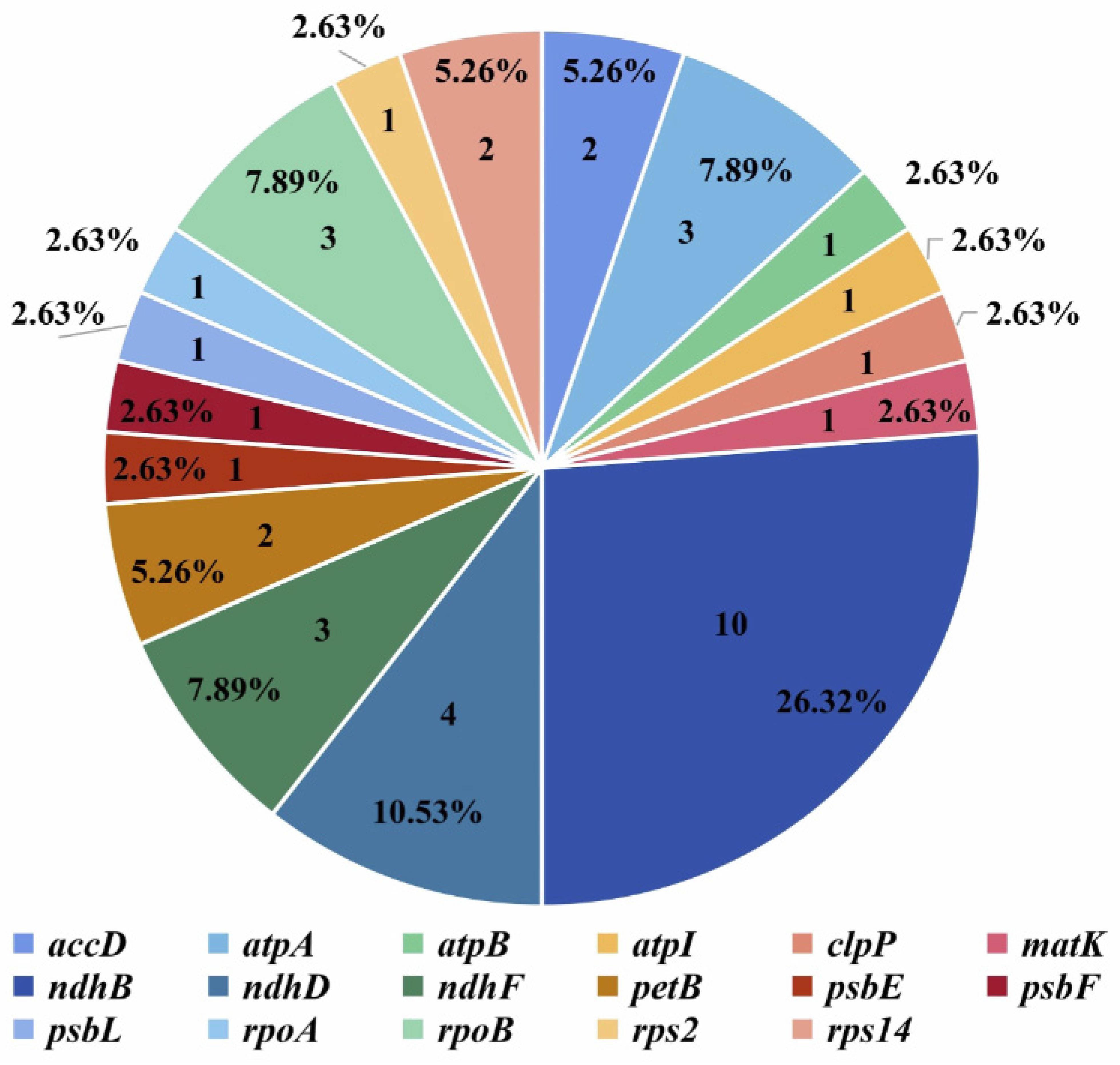

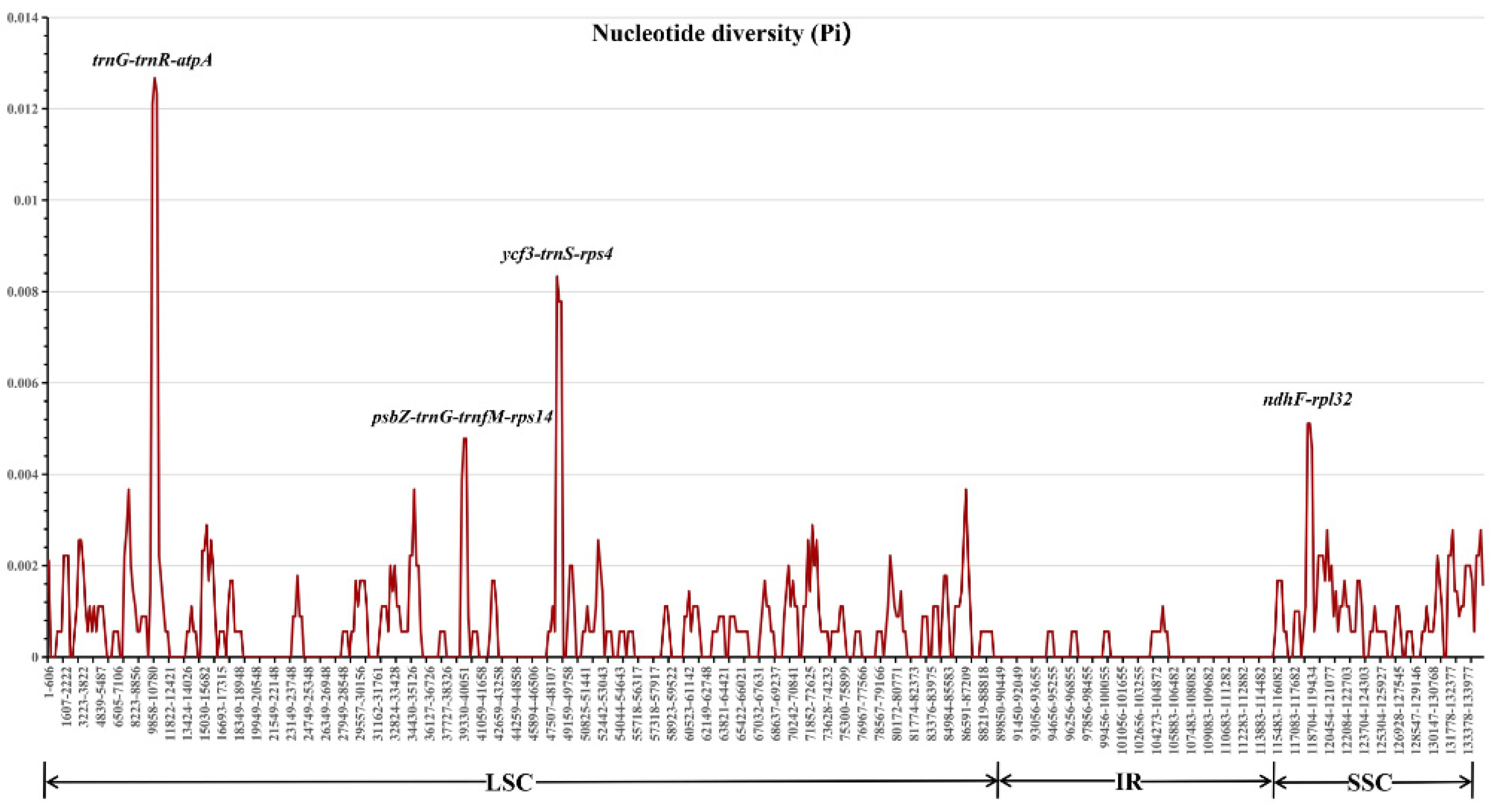
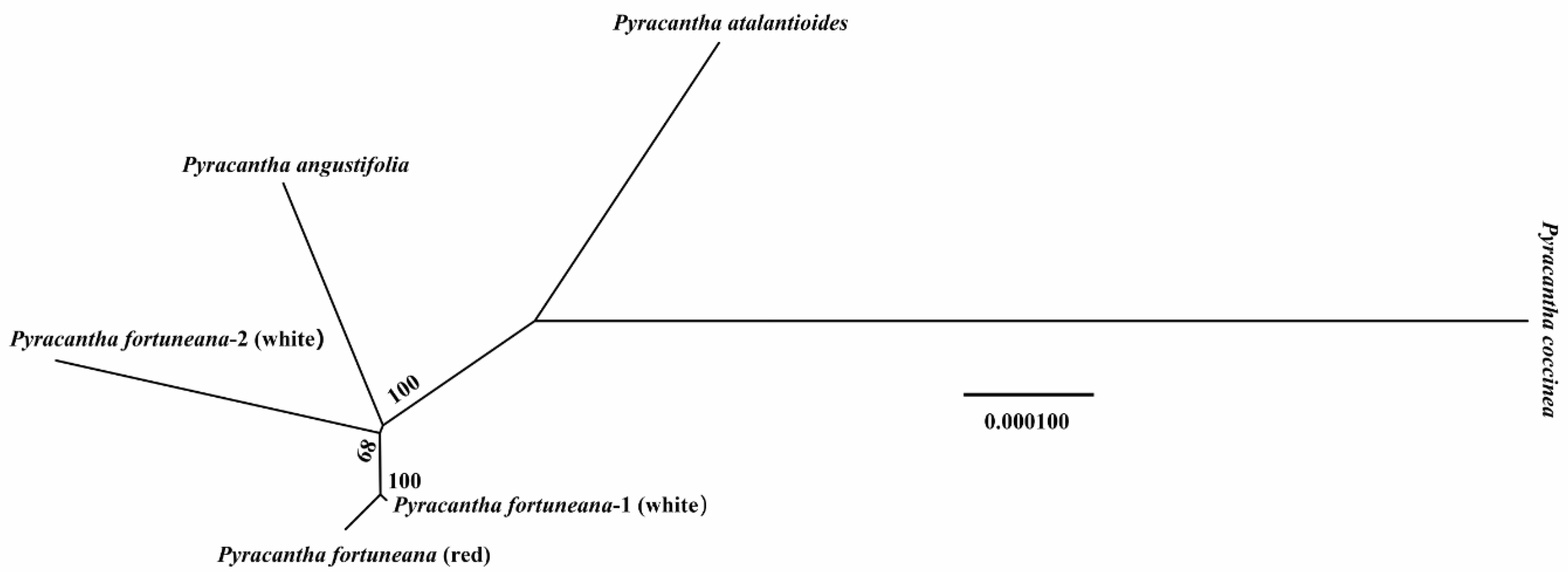
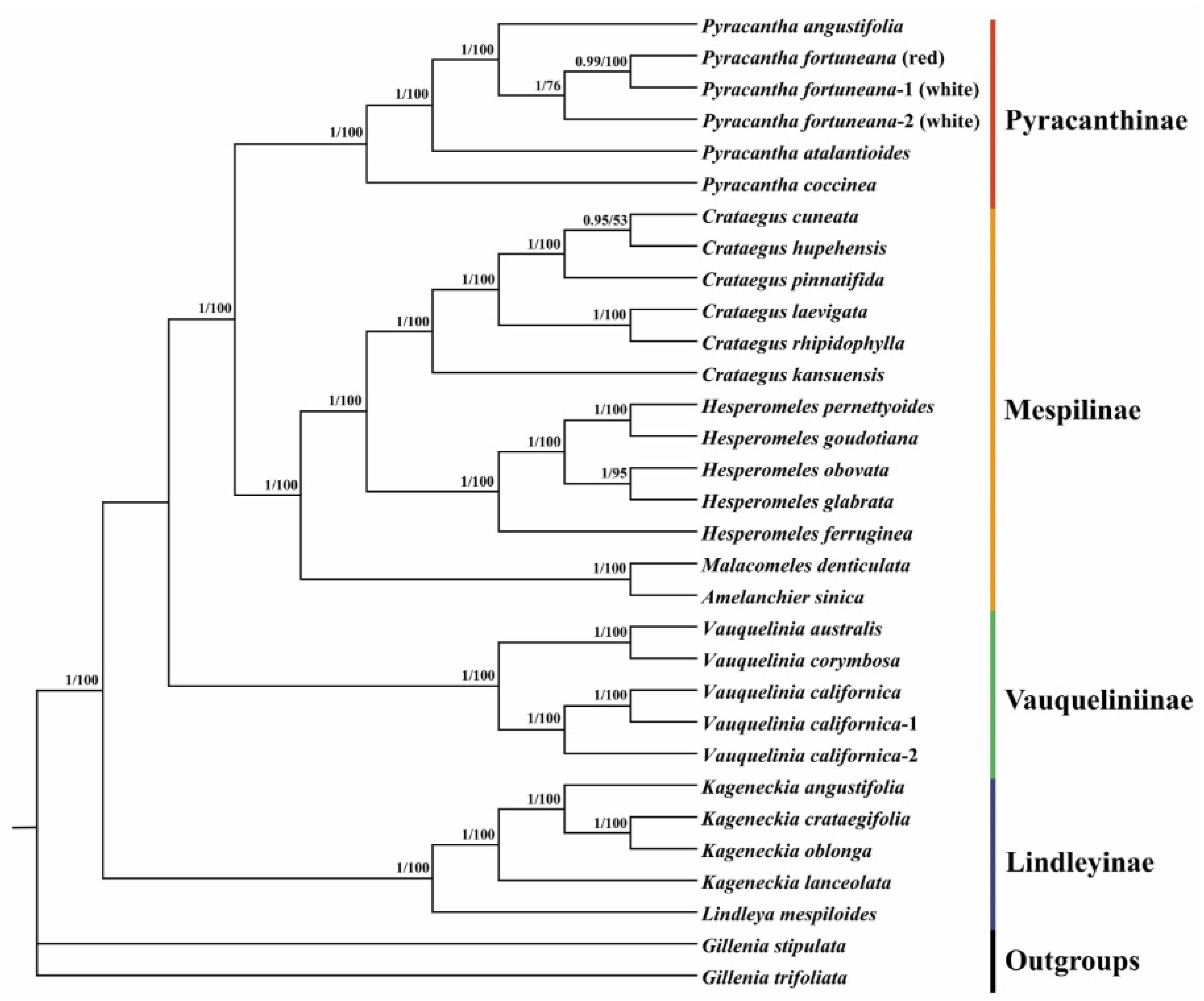
| Species | P. fortuneana (red) * | P. fortuneana-1 (white) | P. fortuneana-2 (white) | P. coccinea | P. atalantioides | |
|---|---|---|---|---|---|---|
| NCBI Accession | OM793283 | NC_059101 | MW596361 | NC_062343 | MW801001 | |
| Size (bp) | Whole | 160,361 | 160,388 | 160,447 | 160,606 | 160,803 |
| LSC | 88,316 | 88,340 | 88,393 | 88,484 | 88,698 | |
| SSC | 19,345 | 19,348 | 19,344 | 19,438 | 19,417 | |
| IR | 26,350 | 26,350 | 26,355 | 26,342 | 26,344 | |
| GC content (%) | Whole | 36.5 | 36.5 | 36.5 | 36.5 | 36.4 |
| LSC | 34.1 | 34.1 | 34.1 | 34.1 | 34 | |
| SSC | 30.4 | 30.4 | 30.4 | 30.3 | 30.4 | |
| IR | 42.7 | 42.7 | 42.7 | 42.7 | 42.7 | |
| Total genes | 131 | 131 | 131 | 131 | 131 | |
| Genes (Duplicated) | PCGs | 86 (7) | 86 (7) | 86 (7) | 86 (7) | 86 (7) |
| tRNA | 37 (7) | 37 (7) | 37 (7) | 37 (7) | 37 (7) | |
| rRNA | 8 (4) | 8 (4) | 8 (4) | 8 (4) | 8 (4) | |
| Category | Groups of Genes | Name of Genes |
|---|---|---|
| Self-replication | Ribosomal RNA | rrn4.5 (2×), rrn5 (2×), rrn16 (2×), rrn23 (2×) |
| Transfer RNA | trnA-UGC 1(2×), trnC-GCA, trnD-GUC, trnE-UUC, trnF-GAA, trnG-GCC, trnG-UCC1, trnH-GUG, trnI-CAU (2×), trnI-GAU 1, (2×), trnK-UUU 1, trnL-CAA (2×), trnL-UAA 1, trnL-UAG, trnM-CAU, trnfM-CAU, trnN-GUU (2×), trnP-UGG, trnQ-UUG, trnR-UCU, trnR-ACG (2×), trnS-UGA, trnS-GCU, trnS-GGA, trnT-GGU, trnT-UGU, trnV-UAC 1, trnV-GAC (2×), trnW-CCA, trnY-GUA | |
| Small subunit of ribosome | rps2, rps3, rps4, rps7 (2×), rps8, rps11, rps12 1,(2×), rps14, rps15, rps16 1, rps18, rps19 | |
| Large subunit of ribosome | rpl21,(2×), rpl14, rpl161, rpl20, rpl22, rpl23 (2×), rpl32, rpl33, rpl36 | |
| RNA polymerase subunits | rpoA, rpoB, rpoC11, rpoC2 | |
| Photosynthesis | Photosystem I | psaA, psaB, psaC, psaI, psaJ |
| Photosystem II | psbA, psbB, psbC, psbD, psbE, psbF, psbH, psbI, psbJ, psbK, psbL, psbM, psbN, psbT, psbZ | |
| Subunits of cytochrome | petA, petB1, petD1, petG, petL, petN | |
| ATP synthase | atpA, atpB, atpE, atpF1, atpH, atpI | |
| NADH-dehydrogenase | ndhA1, ndhB1,, ndhC, ndhD, ndhE, ndhF, ndhG, ndhH, ndhI, ndhJ, ndhK | |
| Other genes | Rubisco large subunit | rbcL |
| Maturase K | matK | |
| Envelope membrane protein | cemA | |
| Acetyl-CoA carboxylase | accD | |
| Proteolysis | clpP2 | |
| Cytochrome c biogenesis | ccsA | |
| Unknown | Conserved open reading frames | ycf1, ycf2 (2×), ycf3 2, ycf4, ycf15 (2×) |
| Amino Acids | Codons | Count | RSCU | Amino Acids | Codons | Count | RSCU |
|---|---|---|---|---|---|---|---|
| Leucine | UUA(L) | 891 | 1.93 | Phenylalanine | UUU(F) | 966 | 1.3 |
| UUG(L) | 568 | 1.23 | UUC(F) | 521 | 0.7 | ||
| CUU(L) | 580 | 1.26 | Tyrosine | UAU(Y) | 790 | 1.61 | |
| CUC(L) | 184 | 0.4 | UAC(Y) | 191 | 0.39 | ||
| CUA(L) | 359 | 0.78 | Histidine | CAU(H) | 491 | 1.55 | |
| CUG(L) | 181 | 0.39 | CAC(H) | 141 | 0.45 | ||
| Isoleucine | AUU(I) | 1113 | 1.48 | Glutamine | CAA(Q) | 729 | 1.55 |
| AUC(I) | 433 | 0.58 | CAG(Q) | 213 | 0.45 | ||
| AUA(I) | 711 | 0.95 | Asparagine | AAU(N) | 973 | 1.53 | |
| Methionine | AUG(M) | 622 | 1 | AAC(N) | 300 | 0.47 | |
| Valine | GUU(V) | 514 | 1.45 | Lysine | AAA(K) | 1049 | 1.5 |
| GUC(V) | 159 | 0.45 | AAG(K) | 353 | 0.5 | ||
| GUA(V) | 547 | 1.54 | Aspartic Acid | GAU(D) | 881 | 1.62 | |
| GUG(V) | 202 | 0.57 | GAC(D) | 207 | 0.38 | ||
| Serine | UCU(S) | 572 | 1.7 | Glutamic Acid | GAA(E) | 1014 | 1.47 |
| UCC(S) | 322 | 0.96 | GAG(E) | 361 | 0.53 | ||
| UCA(S) | 405 | 1.2 | Cysteine | UGU(C) | 226 | 1.51 | |
| UCG(S) | 186 | 0.55 | UGC(C) | 74 | 0.49 | ||
| AGU(S) | 408 | 1.21 | Tryptophan | UGG(W) | 452 | 1 | |
| AGC(S) | 129 | 0.38 | Arginine | CGU(R) | 339 | 1.28 | |
| Proline | CCU(P) | 420 | 1.56 | CGC(R) | 111 | 0.42 | |
| CCC(P) | 195 | 0.73 | CGA(R) | 363 | 1.37 | ||
| CCA(P) | 311 | 1.16 | CGG(R) | 118 | 0.44 | ||
| CCG(P) | 149 | 0.55 | AGA(R) | 490 | 1.84 | ||
| Threonine | ACU(T) | 544 | 1.61 | AGG(R) | 173 | 0.65 | |
| ACC(T) | 243 | 0.72 | Glycine | GGU(G) | 582 | 1.31 | |
| ACA(T) | 416 | 1.23 | GGC(G) | 181 | 0.41 | ||
| ACG(T) | 149 | 0.44 | GGA(G) | 721 | 1.63 | ||
| Alanine | GCU(A) | 642 | 1.84 | GGG(G) | 290 | 0.65 | |
| GCC(A) | 218 | 0.63 | Stop codon | UAA(*) | 51 | 1.78 | |
| GCA(A) | 385 | 1.11 | UAG(*) | 20 | 0.7 | ||
| GCG(A) | 148 | 0.42 | UGA(*) | 15 | 0.52 |
| Codon | Gene | Region | Synonymous Substitution Rate | Non-Synonymous Substitution Rate | p-Value | Total Branch Length |
|---|---|---|---|---|---|---|
| Y | atpI | LSC | 4368.606 | 0.067 | 0.0694 | 0.401 |
| N | ccsA | SSC | 4368.606 | 0.067 | 0.0403 | 0.238 |
| A | matK | LSC | 680.592 | 0.068 | 0.099 | 0.300 |
| P | ndhD | SSC | 628.859 | 0.069 | 0.0874 | 0.210 |
| P | 628.859 | 0.069 | 0.0874 | 0.210 | ||
| K | ndhF | SSC | 1327.452 | 0.070 | 0.0565 | 0.376 |
| A | ndhH | SSC | 1526.202 | 0.068 | 0.0352 | 0.500 |
| Y | psbM | LSC | 1687.808 | 0 | 0.0738 | 0.448 |
| G | rbcL | LSC | 970.757 | 0 | 0.0953 | 0.288 |
| P | rpoC1 | LSC | 1822.725 | 0 | 0.0715 | 0.317 |
| K | rps18 | LSC | 2081.359 | 0 | 0.0538 | 0.339 |
| T | 1168.659 | 0 | 0.0942 | 0.348 |
| Species | 1 | 2 | 3 | 4 | 5 | 6 | |
|---|---|---|---|---|---|---|---|
| 1 | P. fortuneana (red) | ||||||
| 2 | P. fortuneana-1 (white) | 0.000 | |||||
| 3 | P. fortuneana-2 (white) | 0.000 | 0.000 | ||||
| 4 | P. angustifolia | 0.000 | 0.000 | 0.000 | |||
| 5 | P. atalantioides | 0.000 | 0.000 | 0.001 | 0.001 | ||
| 6 | P. coccinea | 0.001 | 0.001 | 0.001 | 0.001 | 0.001 |
| Characters | Red Flower Phenotype | White Flower Phenotype |
|---|---|---|
| Plant habit | evergreen or semi-evergreen shrub, mature leaves turn red in winter | evergreen shrub, mature leaves keep green in winter |
| Leaf | leaf blade obovate to obovate-oblong, base cuneate to wide round | leaf blade obovate-oblong, base cuneate, extending down to the petiole |
| Serrations | serrations conspicuous or inconspicuous | serrations obtuse or inconspicuous |
| Inflorescence | compound corymb, loose, fewer flowers | compound corymb, dense, more flowers |
| Calyx lobes | inner sepals red to pink | inner sepals white |
| Flower | petals, styles and filaments red to pink | petals, styles and filaments white |
| Phenology | fl. Mar–May, fr. Aug–Nov | fl. Mar–June, fr. Aug–Nov |
| Habitat | Alt. 750–1500 m | Alt. 500–2800 m |
Publisher’s Note: MDPI stays neutral with regard to jurisdictional claims in published maps and institutional affiliations. |
© 2022 by the authors. Licensee MDPI, Basel, Switzerland. This article is an open access article distributed under the terms and conditions of the Creative Commons Attribution (CC BY) license (https://creativecommons.org/licenses/by/4.0/).
Share and Cite
Ding, S.-X.; Li, J.-C.; Hu, K.; Huang, Z.-J.; Lu, R.-S. Morphological Characteristics and Comparative Chloroplast Genome Analyses between Red and White Flower Phenotypes of Pyracantha fortuneana (Maxim.) Li (Rosaceae), with Implications for Taxonomy and Phylogeny. Genes 2022, 13, 2404. https://doi.org/10.3390/genes13122404
Ding S-X, Li J-C, Hu K, Huang Z-J, Lu R-S. Morphological Characteristics and Comparative Chloroplast Genome Analyses between Red and White Flower Phenotypes of Pyracantha fortuneana (Maxim.) Li (Rosaceae), with Implications for Taxonomy and Phylogeny. Genes. 2022; 13(12):2404. https://doi.org/10.3390/genes13122404
Chicago/Turabian StyleDing, Shi-Xiong, Jia-Chen Li, Ke Hu, Zi-Jian Huang, and Rui-Sen Lu. 2022. "Morphological Characteristics and Comparative Chloroplast Genome Analyses between Red and White Flower Phenotypes of Pyracantha fortuneana (Maxim.) Li (Rosaceae), with Implications for Taxonomy and Phylogeny" Genes 13, no. 12: 2404. https://doi.org/10.3390/genes13122404





